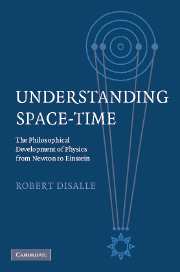3 - Empiricism and a priorism from Kant to Poincaré
Published online by Cambridge University Press: 22 September 2009
Summary
Newton presented not only a theory of absolute space and time, but a philosophical approach to the analysis of space and time quite unlike anything contemplated by his contemporaries. It cannot be viewed as a complete philosophical account of space and time, however, because it treats space and time solely from the perspective of classical mechanics – that is, as concepts implicitly presupposed by the classical mechanical understanding of causality and force. A philosophically thorough treatment of the problem would embrace, not only the implicit metaphysics of physics, but the general epistemological problem of space and time and the ways in which physics, and human knowledge generally, have some access to them. In other words, the step beyond what Newton accomplished required an attack on what later became known as “the problem of physical geometry.” The revolutionary development of space-time geometry in the twentieth century, in both special and general relativity, is only the most spectacular of the many far-reaching consequences of this philosophical effort.
As we saw, Newton's theory was forced into confrontation with the most prominent general philosophical accounts of space and time, namely those of Descartes and Leibniz. But its rejoinder to them was only that those philosophical views could not be reconciled with their own views of physics. Undoubtedly this was a compelling argument as far as it goes, one which neither Descartes nor Leibniz was in a position to answer on its own terms.
- Type
- Chapter
- Information
- Understanding Space-TimeThe Philosophical Development of Physics from Newton to Einstein, pp. 55 - 97Publisher: Cambridge University PressPrint publication year: 2006



